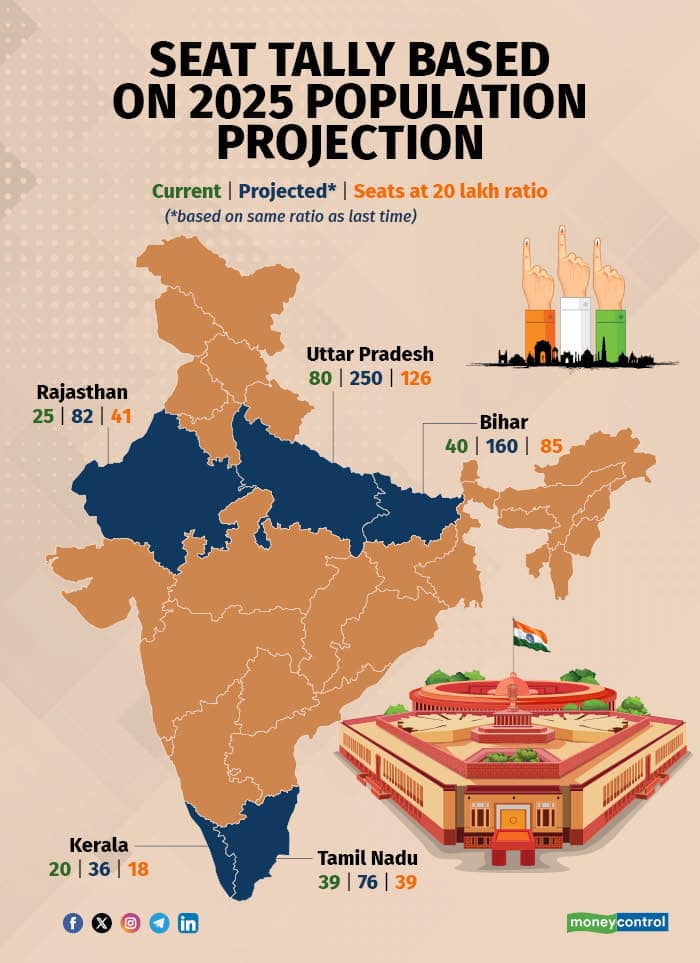



The delimitation exercise, expected next year, is the latest flashpoint between Tamil Nadu's ruling DMK and the BJP-led central government.
While MK Stalin described the implications of constituency delimitation as a “sword dangling” over Tamil Nadu, Union Home Minister Amit Shah dismissed the Chief Minister’s claim that the state would lose eight Lok Sabha seats due to delimitation.
Prime Minister Narendra Modi for the first time waded into the looming issue of delimitation during a rally in Telangana. Speaking in Nizamabad, he used the phrase “Jitni aabadi, utna haq”, first mentioned by Congress leader Rahul Gandhi during the Karnataka Assembly elections to press for a caste census and argued that southern states would lose representation in the Lok Sabha if the Congress’ formula of proportional representation was to be applied.
What is delimitation?
Delimitation is essentially the process of fixing the number of seats and boundaries of territorial constituencies in each state for the Lok Sabha and Legislative assemblies. It usually is based on the population in the most recent Census. According to Article 82 of the Constitution, the allocation of Lok Sabha seats to each state must be adjusted based on population changes after each Census is completed.
This delimitation process is performed by the Delimitation Commission that is set up under an act of Parliament.
History of delimitation
This delimitation was carried out after the 1951, 1961 and 1971 Census. Until 1976, after every Indian Census, the seats of Lok Sabha, Rajya Sabha and state legislative Assemblies redrawn across the country. However, the 42nd Amendment to the Constitution, passed during the Emergency, froze the total number of Parliamentary and state Assembly seats till the 2001 Census.
In 2001, the boundaries of constituencies were redrawn, but the number of seats remained unaltered.
How will the 2026 exercise look like?
In 2026, the estimated population of India will reportedly be 1.42 billion. The census and delimitation exercise that will precede the implementation of Women's Reservation Bill, is expected to increase the number of Lok Sabha seats from 543 to 753. The Women's Reservation Bill, which provides 33% reservation for women in elections, was passed by Parliament in 2023.
According to Indian Express, in the 1977 Lok Sabha, every MP in India represented 10.11 lakh people on average. However, every constituency cannot have the same population. Going by the 10.11 lakh average now, the strength of Lok Sabha would shoot up to nearly 1,400 as per the Union Health Ministry’s population projection for 2025.
This would also mean that the Lok Sabha seats of Uttar Pradesh (including Uttarakhand) would go up from 85 to 250. Then Bihar and Jharkhand’s combined seats would increase from 54 to 169 Similarly, Rajasthan’s would increase from 25 to 82.
Meanwhile, Tamil Nadu’s share would increase from 39 to only 76 and Kerala’s seats would rise from 20 to 36. However, the 10.11 lakh average is not likely to be retained as the base is that the new Parliament building has provision to seat only 888 in the Lok Sabha.
If the average population per constituency is doubled to 20 lakhs for the purpose of delimitation, it would give the Lok Sabha 707 seats as compared to 543 now. Tamil Nadu’s seats would remain the same at 39 but Kerala would lose two seats and end up with 18.

Carnegie Endowment projection
A 2019 report by the Carnegie Endowment for International Peace stated that if delimitation is done based on population considering that no state is to lose representation, the Lok Sabha would have to consist of 846 representatives.
In that case, the northern states such as Uttar Pradesh, Bihar, Jharkhand, Rajasthan, Delhi, Madhya Pradesh and Haryana would have a total of 378 seats and if states like Maharashtra and Odisha are added, it would jump to 482, way above the majority mark. Meanwhile, the southern states like Andhra, Telangana, Karnataka, Kerala, Puducherry and Tamil Nadu will have 165 seats together.
Why is Tamil Nadu worried?
Regional parties from the South feel that delimitation based on population could skew elections in favour of parties. In his tweet on February 25, Chief Minister MK Stalin said delimitation was just about Tamil Nadu; that it affected all of south India.
“As the Chief Minister of Tamil Nadu, I bring to everyone's attention that the Lok Sabha delimitation exercise based on the 2026 Census is extremely dangerous. Southern states like Tamil Nadu have done a great job in controlling population growth. But if that is the reason why our strength in Parliament will decrease, if it can suppress our voice, how can it be justified?” Stalin said on Tuesday, announcing an all party meeting to be held on March 5.
According to the 2024 study by KS James and Shubhra Kriti from India Forum, all southern states have experienced a considerable decline and their population shares are projected to decline further in between 1951 and 2101. Tamil Nadu, Kerala, Andhra Pradesh (including Telangana) and Karnataka showed a decline in their population shares by 54%, 49%, 38% and 29%, respectively, between 1951 and 2101.
Stalin has been arguing that the process would weaken southern states' representation in Parliament and undermine their contributions to national development.
Discover the latest Business News, Sensex, and Nifty updates. Obtain Personal Finance insights, tax queries, and expert opinions on Moneycontrol or download the Moneycontrol App to stay updated!
Find the best of Al News in one place, specially curated for you every weekend.
Stay on top of the latest tech trends and biggest startup news.